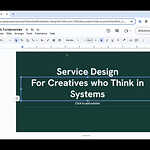Firstly, we updated our free UX jobs boards this week! You can access 200+ entry-level UX jobs here, updated TODAY. We also created a remote UX jobs board with over 200+ remote jobs- check it out here. The VIP versions of both our jobs boards were also updated, and can be accessed by subscribing below ($6.67/month). We added over to 80+ remote UX jobs to our remote UX jobs board today. Now onto UX politics 101….
Perception is everything when it comes to landing a UX job, keeping that job, and even getting promoted. What if I told you that it was possible to get promoted to a “Senior UX Designer” or “Senior UX Researcher” role after just 1 year on the job as a “Junior UX Designer” or “Design Research Associate”?
It’s possible. When I was a new grad, I landed my first UX role as a Design Research associate for a consulting firm. I joined a small cohort of other new hires, including another UX Design associate who was also a new grad. We became friends and were teamed up on the same projects initially.
As a recent graduate within my very first UX role, I lacked confidence when it came to working on client projects, needing constant re-assurance I was doing the right thing. I welcomed feedback and critique, almost too much, and was eager to learn about everything UX design and UX research. My friend, on the other hand, acted like she was a Senior UX designer from day one on the job, presenting her work with confidence and getting very specific on where she needed feedback on her work during our team design crit sessions, even pushing back on senior designers if she didn’t agree with the feedback they shared.
Guess who got promoted? Within a year, my friend got a pay raise and a promotion to a Senior UX designer title, while my role with the company stayed the same. We had worked on a lot of the same client projects together, but the perception of her at the company was that she was a senior UX designer, and I was not.
I like to share failed moments or twists and turns in my UX career as a lesson, just like how my closest mentors have shared their failed career and entrepreneurship moments with me. I came to realize that perception on the job mattered more than reality. With 18 months at the company, I started interviewing for new UX jobs, landing a UX strategy role that gave me a salary bump and a chance to rebuild this new team’s perception of me. I went on to set up and lead UX research practices at an e-commerce T-shirt company, influencing the C-suite in their design and business decisions.
So how do you influence perception at your UX role? It starts within the first 90 days on the job, how you communicate with UX managers, UX team members, and set expectations and boundaries alike to earn their trust. We put together a whole 60-minute playbook on UX politics 101 and how to earn stakeholder trust in those first 90 days on the job, published to our YouTube channel.
Over my 9+ year career in UX, I’ve been able to “hit the ground running” at a variety of startup, corporate, and consulting roles by setting myself up for success within the first 90 days on the job or gig. This means truly understanding the differences between startup, consulting and corporate work cultures.
Startup work cultures tend to require “jack of all trades” product designers who are well versed in UX design and UX research, leading and setting up all design and research practices for the company. Startups also have a fast paced work environment, where product designers might work in two-week sprints in sync with the development team.
Consulting companies (i.e., boutique agencies and large national or global consulting firms) tend to have teams of distinct creatives (i.e, UX researchers, content designers, UX designers) who work together on client projects, collaborating to create deliverables and present them to clients. It is natural to work on anywhere between 1-3 client projects at a time, each lasting anywhere between 1-3 months.
Corporate work cultures tend to have the highest salaries and best benefits packages, where you can expect to spend time on 1-2 large projects every 1-2 months. At corporations, it is just as important to distribute and market your work, as it is to actually do the work. Expect to spend 50% of your time doing the work, and 50% of your time facilitating conversations that spread your work impact across the organization.
Design maturity at your workplace also matters a lot, and can really have an impact on the perception that folks at a company have of you, your work, and your work’s impact. At a design mature organization the design process is made clear across all cross-functional teams and there’s a UX process in place for completing all project work. UX touches nearly ALL projects at the company. This means that there’s a healthy mix of innovative new product/feature development, as well as more tactical initiatives to optimize existing products/features. In design mature orgs, there’s usually a clear design leadership presence at the C-Suite or VP level, so there’s usually a Chief Design Officer or VP of Design at the company.
At a design immature organization, there is no defined design process, or a very loosely defined one. UX design at this type of company is definitely NOT prioritized across all initiatives, and might even be an afterthought. There tends to be less innovation around their product or service offerings, and more focus on sales, marketing, customer service, and engineering. At these types of companies, UX initiatives tend to be scoped and vetted at the customer service or sales levels, sporadically and reactively, whenever a problem comes up with customers. UX initiatives don’t tend to be prioritized or scoped at the executive level and there is no design presence within the leadership of the organization (i.e., no Chief Design Officer or VP of Design). Instead, the few creatives who might work at the company tend to work under the Marketing department.
As someone who’s worked at both design mature and design immature organizations, I want to set my mentees up for success at any UX role they land, to ensure they don’t repeat the same failures that I made early on in my UX career. This is why our 7-Month UX Design MBA focuses on a rigorous learning approach that covers the end-to-end design process, where students learn to work and succeed in some of the toughest workplace cultures (i.e., design immature startups and corporates). This prepares them for anything and everything when they land their first UX role, allowing them to hit the ground running.
So how do our students learn to handle design immature startup and corporate work?
They learn to use the design process as a sales tool, educating senior stakeholder, product managers, and project managers on what the end-to-end design process looks like and why each step matters.
They co-create with senior stakeholders and cross-functional teams, leading and facilitating ideation and strategy workshops as the design expert in the room, while still allowing for other cross-functional expertise and feedback and shine through, coming to a compromise between design strategy, business strategy, tech and operations constraints.
They learn to push back on unreasonable requests, like not doing basic UX research and context gathering to kickoff a design project OR overly-tight UX project timelines that would be impossible to deliver on. This requires earning and building trust with stakeholders and clients, as outlined in our UX Politics 101 playbook.
They learn to build stakeholder and client trust with storytelling skills that showcase their qualitative and quantitative UX methods, combining the emotional WHY of the user, with business metrics that showcase the scalability of a product or feature launch.
They learn to define and set up UX design and research practices for a design immature organization. This often means starting scrappy, with a lean startup approach in mind, and then gradually adding nuance and rigor to improve the design process at the company over time as stakeholder trust is earned.
Listen to this episode with a 7-day free trial
Subscribe to Samaya, your UX woman. to listen to this post and get 7 days of free access to the full post archives.








